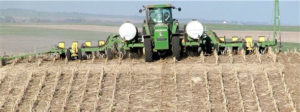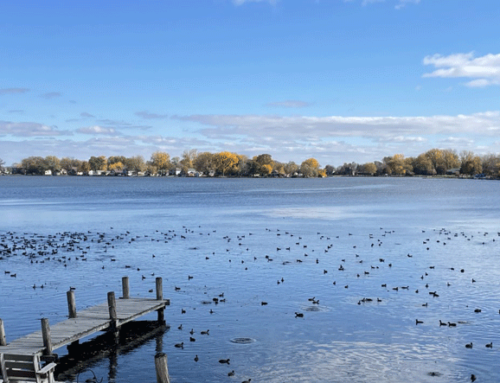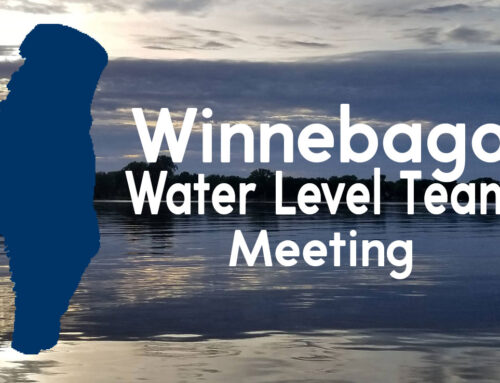
Freshly cut hay on the author’s Wisconsin farm
We are America’s dairy land. One of the first things to come to mind when people think of Wisconsin is a rolling pastoral landscape, complete with a red bank barn and a herd of Holsteins. When viewed from above, a mosaic of crops in various rotations blankets the state, divided only by roads and waterways. These millions of acres play an extremely important role in our state’s economy, culture, and the state of our water quality.
Wisconsin began acquiring some of the best agricultural soils in the entire world when the glaciers started to recede about 20,000 years ago. The annual cycle of birth and death of the Wisconsin prairies went on for thousands of years, all the while building an amazing soil capable of producing some of the best crop yields in the world. This profound soil developed in the absence of tillage. However, there was disturbance, and plenty of it. Fires ripped through the landscape, and the buffalo grazed it down, but that was periodic and never involved turning over the soil. The soils developed tremendous amounts of organic matter, which plays an important role in the soil’s ability to hold water, keep soil aggregates together, provide plants with needed nutrients, and serve as habitat for beneficial macro and microorganisms.

So what’s no-till?
No-till farming is actually old news, and was introduced in the 1940s in Edward Faulkner’s book, the “Plowman’s Folly.” Coming out of the 1930s Dust Bowl, Faulkner blamed the environmental calamity on the then universally accepted moldboard plow. He dropped a bomb on the agricultural world with his simple statement, “The fact is that no one has ever advanced a scientific reason for plowing.” Faulkner recognized that tillage was hard on soil health, that it contributed to greater rates of soil erosion, and that tilled soils are more susceptible to drought and often require more fertilizers.
No-till farming is a farming method that most closely mimics the way in which our state acquired its prolific soils. In spring, farmers going no-till drill seeds directly into the ground with a special implement that first cuts a very thin furrow in the soil, drops a seed in, and then closes the furrow. It’s not all that different from a normal seed drill, but can operate without a tilled and finely prepared seed bed. Weeds are often sprayed off with a herbicide prior to planting the seed. No-till farming is often paired with cover crops, which are planted after the main crop is harvested. Annual cereals (oats, barley, rye, or wheat), radishes/turnips, or annual/perennial grasses like ryegrass or sudan-grass are all commonly used cover crops. The roots of these cover crops anchor down soil, preventing erosion, and also add organic matter to the soil upon their death and decay. The vegetative part of the cover crop can be harvested or left on the soil as a mulch.
In the video below, we are using a no-till seeder to plant orchard grass and red clover into wheat stubble on my farm. Notice the ground is not exposed soil, but crop residue.

No-till planting into corn stubble. Photo: Outagamie County LWCD
Aside from mimicking the soil building process of the great Wisconsin prairies, no-till farming has many positive benefits to water quality. One of the most important is its effect on reducing erosion and field runoff. The organic matter that builds up rapidly in no-till soils bonds soil aggregates together, which holds the field together. Visit one of the clay dominated fields characteristic to our region and walk through a muddy spot on a no-till field. The soil will not stick to your boots. Cross the road to the heavily tilled field next door, and you’ll have 10 pound weights on your feet. On conventionally tilled fields the rain will remove that soil just like your boots did because there is no organic matter and root structure to hold it all together.
When that soil is lost, it makes its way into our lakes, and causes a loss of water quality by introducing phosphorus and suspended solids into the water. Runoff is further reduced because organic matter also increases the soil’s ability to absorb and hold water. A 1% increase in soil organic matter can absorb an additional 20,000 or more gallons of water per acre. It’s easy to see how critical healthy soil is to water quality when you couple together how organic matter absorbs water and how it holds soil aggregates together.
So, that’s why the Lake Management Plan will work with local agencies and counties to help equip farmers with the resources they need to go no-till and plant cover crops. For example, Fox-Wolf’s work in the Lower Fox watershed helped equip Outagamie county with no-till farming implements that the county can rent out to farmers. It’s not easy to adopt a new farming system because it can be expensive and requires a new way of farming and planning, so helping farmers overcome those barriers is an effective way to get more no-till on the ground. The draft TMDL report released by the WDNR suggests that the majority of phosphorus and sediment pollution is coming from agriculture, which is why improving farming practices that promote soil health is going to be one of the most important components of reducing the nutrient load coming into the Winnebago System. Properly executed, no-till planting and cover cropping is a win-win for the farmer and the water.
Winnebago Waterways is a Fox-Wolf Watershed Alliance program. The Fox-Wolf Watershed Alliance is an independent nonprofit organization that identifies and advocates effective policies and actions that protect, restore, and sustain water resources in the Fox-Wolf River Basin.
Follow the Fox Wolf Watershed Alliance’s Winnebago Waterways Program on our Winnebago Waterways Facebook page or @WinnWaterways on Twitter! You can also sign-up for email updates at WinnebagoWaterways.org.
This article was written by Austin Pethan for the Winnebago Waterways Program. Questions or comments? Contact Austin at austin@fwwa.org or (920) 920-851-4295.





